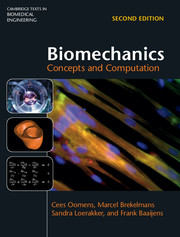Book contents
- Frontmatter
- Contents
- About the Cover
- Preface to the First Edition
- Preface to the Second Edition
- 1 Vector and Tensor Calculus
- 2 The Concepts of Force and Moment
- 3 Static Equilibrium
- 4 The Mechanical Behaviour of Fibres
- 5 Fibres: Time-Dependent Behaviour
- 6 Analysis of a One-Dimensional Continuous Elastic Medium
- 7 Biological Materials and Continuum Mechanics
- 8 Stress in Three-Dimensional Continuous Media
- 9 Motion: Time as an Extra Dimension
- 10 Deformation and Rotation, Deformation Rate and Spin
- 11 Local Balance of Mass, Momentum and Energy
- 12 Constitutive Modelling of Solids and Fluids
- 13 Solution Strategies for Solid and Fluid Mechanics Problems
- 14 Solution of the One-Dimensional Diffusion Equation by Means of the Finite Element Method
- 15 Solution of the One-Dimensional Convection–Diffusion Equation by Means of the Finite Element Method
- 16 Solution of the Three-Dimensional Convection–Diffusion Equation by Means of the Finite Element Method
- 17 Shape Functions and Numerical Integration
- 18 Infinitesimal Strain Elasticity Problems
- References
- Index
16 - Solution of the Three-Dimensional Convection–Diffusion Equation by Means of the Finite Element Method
Published online by Cambridge University Press: 02 February 2018
- Frontmatter
- Contents
- About the Cover
- Preface to the First Edition
- Preface to the Second Edition
- 1 Vector and Tensor Calculus
- 2 The Concepts of Force and Moment
- 3 Static Equilibrium
- 4 The Mechanical Behaviour of Fibres
- 5 Fibres: Time-Dependent Behaviour
- 6 Analysis of a One-Dimensional Continuous Elastic Medium
- 7 Biological Materials and Continuum Mechanics
- 8 Stress in Three-Dimensional Continuous Media
- 9 Motion: Time as an Extra Dimension
- 10 Deformation and Rotation, Deformation Rate and Spin
- 11 Local Balance of Mass, Momentum and Energy
- 12 Constitutive Modelling of Solids and Fluids
- 13 Solution Strategies for Solid and Fluid Mechanics Problems
- 14 Solution of the One-Dimensional Diffusion Equation by Means of the Finite Element Method
- 15 Solution of the One-Dimensional Convection–Diffusion Equation by Means of the Finite Element Method
- 16 Solution of the Three-Dimensional Convection–Diffusion Equation by Means of the Finite Element Method
- 17 Shape Functions and Numerical Integration
- 18 Infinitesimal Strain Elasticity Problems
- References
- Index
Summary
Introduction
The two- and three-dimensional convection–diffusion equations play an important role in many applications in biomedical engineering. One typical example is the analysis of the effectiveness of different types of bioreactors for tissue engineering. Tissue engineering is a rapidly evolving interdisciplinary research area aiming at the replacement or restoration of diseased or damaged tissue. In many cases, devices made of artificial materials are only capable of partially restoring the original function of native tissues, and may not last for the full lifetime of a patient. In addition, there is no artificial replacement for a large number of tissues and organs. In tissue engineering, new, autologous tissues are grown. The tissue proliferation and differentiation process is strongly affected by mechanical stimuli and transport of oxygen, minerals, nutrients and growth factors. To optimize bioreactor systems, it is necessary to analyse how these systems behave. The convection–diffusion equation plays an important role in this kind of simulating analysis.
Figure 16.1 shows two different bioreactor configurations, both of which have been used in the past to tissue engineer articular cartilage. The work was especially focussed on glucose, oxygen and lactate, because these metabolites play a major role in the biosynthesis and survival of chondrocyte. Questions ranged from: ‘Does significant nutrient depletion occur at the high cells concentrations required for chondrogenesis?’ to ‘Do increasing transport limitations due to matrix accumulation significantly affect metabolite distributions?’ Figure 16.2 shows a typical result for the calculated oxygen distributions in the two bioreactor configurations.
This chapter explains the discretization of the convection-diffusion equation in two or three dimensions. First, the diffusion equation is discussed; thereafter, the convection–diffusion equation is elaborated. The spatial discretization of the weighting function is based on the Galerkin method.
Diffusion Equation
Consider a two- or three-dimensional domain with boundary. As in the onedimensional model problem, the boundary is split into a part along which the essential boundary conditions are specified, and a part along which the natural boundary conditions may be specified. The generic form of the diffusion equation is given by
Information
- Type
- Chapter
- Information
- BiomechanicsConcepts and Computation, pp. 342 - 362Publisher: Cambridge University PressPrint publication year: 2018
